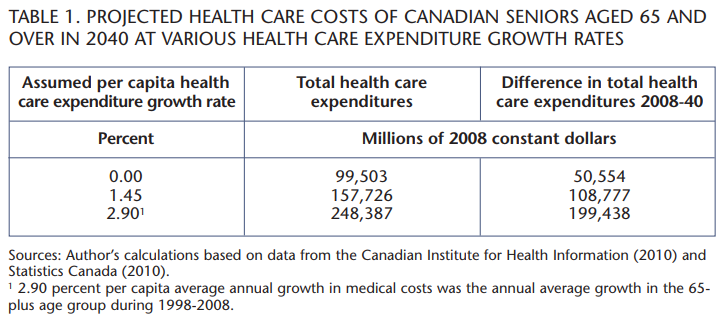
The issue of guaranteed annual income to alleviate poverty must be considered together with economic growth. When a country’s economy grows, people get richer and they are able to spend more on things they want and need. But governments also have more money to spend on things that society values, such as health care, child care, language classes for new immigrants, roads and education. Most economists believe that economic growth is a necessary condition to maintain prosperity. Economic growth leads to economic stability, and economic stability is, in turn, a necessary condition of material and social stability. Slowing economic growth could potentially lead to social instability.
The implementation of a guaranteed annual income in Canada, when coupled with the upcoming retirement of the baby boomers, would have the potential to derail economic growth by reducing the overall labour supply. And the growth in the labour force is one of the most important components of economic growth. Other important components are growth in education levels, technology, and equipment and machinery.
Philippe Van Parijs provides a useful starting point in defining what constitutes a guaranteed annual income. He refers to it as a “basic income” and defines it as an income paid in cash by a political community to all its members on an individual basis, without a means test or a work requirement. Therefore, two key characteristics of a guaranteed annual income are (1) it is non-means-tested; therefore, everyone is entitled to it, irrespective of one’s income or wealth level, and (2) it is a citizen’s right, independent of one’s employment status and willingness or ability to work.
Another key characteristic of a guaranteed annual income is it would see all eligible members receive a transfer that would enable them to lead a minimally decent life. This transfer would be “clawed back” to the government with each dollar of income received. Finally, most proposals of a basic income suggest that its implementation should go together with a partial to a full elimination of existing government transfer payments, such as child benefits and unemployment benefits.
It is important to note that no country has yet introduced a guaranteed annual income as a pillar of welfare state reform. Guaranteed annual income programs have been suggested for some developing countries, such as South Africa; however, these governments have been reluctant to implement these policies due to large income tax increments. Instead, they have focused on job creation through expanded public works programs and industrial policies to promote income security through employment.
Implementing a guaranteed annual income could lead to at best very little increase and most likely no increase in prosperity for most Canadians over the next 30 years.
Therefore, we do not really know what the effects of a guaranteed annual income would be, as most proposals have failed to make their way into actual policy, with the exception of the Alaska Permanent Fund Dividend Program. However, the Alaska program is an equal annual cash distribution to every resident regardless of her or his circumstances of one-half of the earnings of the Alaska Permanent Fund. The only eligibility test is whether a person has been and intends to remain a resident. Furthermore, there is no clawback provision. Therefore, the Alaska program is simply a vehicle for sharing some of the revenues from the publicly owned natural resource, namely oil, to all residents and not social policy with the objective of poverty reduction. It is also an incentive for people to live there. This is similar to Alberta’s 2006 Prosperity Bonus, which was a onetime $400 payment to distribute some of the oil and gas royalties to the residents of Alberta.
All of the potential effects of a guaranteed annual income on an economy with well-developed welfare and other social systems like Canada’s are seen in either pilot experiments (in the US and Manitoba during the 1960s and 1970s) or labour-supply models.
Generally speaking, the results indicate that if we believed that income taxes would drop with a guaranteed annual income program, we would be wrong. A 1998 Australian study shows that to produce a guaranteed annual income under a basic income/flat tax system (a tax system similar to the tax system in Alberta) that leaves no existing social security recipient worse off (for example, basic income at least as high as current unemployment benefits) would require a tax rate of about 57 percent. At the time of the Australian study, the top income tax rate in Australia was 47 percent. Here in Canada, in 2010 the top tax rates for Alberta and Ontario were 39 percent and 46.4 percent, respectively. Furthermore, the Australian study found that dropping the tax rate to 45 percent would result in a 25 percent reduction in the amount of the guaranteed annual income.
In addition to the income tax effects, the experiments and labour models found that the implementation of a guaranteed annual income would cause a reduction in the labour supply. More specifically, the results of the US experiments and labour supply models such as those of Kesenne, Levine et al., Mancini, and Nelissen and Polk indicate that the labour supply of men would hardly change, mostly because paid work is an essential part of the Western masculine identity, but that the effect of a guaranteed annual income on women’s labour supply would be much greater. The total labour supply of women within a country would drop significantly.
These results indicate that women would be disproportionately affected by the implementation of a guaranteed annual income. A principal reason for this result is that it is highly unlikely that a guaranteed annual income would coexist with the wide range of the existing programs that support child rearing, such as daycare tax credits and child care benefit payments. Therefore, for many families daycare would be unaffordable. That is, a guaranteed annual income would introduce a very high cost for mothers to take a job or stay in a job, as they would have to pay for child care, and at the same time would likely be paying between 40 percent and 60 percent taxes on labour income. So while a guaranteed annual income is often lauded for taking away the unemployment trap or poverty trap, it would likely introduce a child care trap. Mancini shows in a Italian study that a guaranteed annual income would lead to strong labour disincentive effects for married women with children Furthermore, Robeyns shows in a Swedish study that the implementation of a guaranteed annual income program could result in a drop in labour supply of women between 20 and 30 percent. Finally, the experiments performed in the US during the 1960s by Levine et al. resulted in a labour supply decrease of 13 percent in the pilot communities (implying a 7 to 8 percentage point drop in the total labour force participation rate). Most of this decrease was attributed to a very large reduction in the labour supply of women; there was very little to no reduction among men.
The consequences of the upcoming retirement of the baby boomers can be used to provide some light on the effect of a large reduction in labour supply on the economy if Canada were to implement a guaranteed annual income. McGill University economist Christopher Ragan recently looked at the babyboomer issue and claims that the labour force participation rate in Canada, namely the percentage of adults in the workforce, will fall from over 67 percent to 60 percent between 2010 and 2040. Ragan projects that this 7 percentage point drop over the next 30 years would result in a 1 percentage point reduction in per capita economic growth per year. If we assume that the implementation of a guaranteed annual income would cause a further 7 percentage point decrease in the labour force participation rate in Canada over the same 2010-40 period, then we can use Ragan’s numbers to examine the potential economic impact of a guaranteed annual income. The assumption of a 7 percentage point decrease in the total labour supply is similar to the decrease witnessed in the US experiments in the 1960s, and I believe it to be quite conservative. Using Ragan’s numbers, we can estimate that a 7 percentage point decrease in the labour supply over the next 30 years would result in an additional 1 percentage point drop in economic growth per capita per year.
So the combined effects of a guaranteed annual income and the upcoming retirement of the baby boomer cohort could see Canada’s economic growth per capita drop by about 2 percentage points. It is important to examine this value in the context of Canada’s economic growth per capita over the 1971 to 2010 period, when its economy grew at about 1.9 percent per capita annually. If Canada were to pursue a guaranteed annual income, growth in GDP per capital could grind to a halt. Implementing a guaranteed annual income could lead to at best very little increase and most likely no increase in prosperity for most Canadians over the next 30 years.
Therefore, the implementation of a guaranteed annual income in Canada, coupled with the upcoming retirement of the baby boomers, has the potential to derail economic growth. When analyzed together with the anticipated increase health care expenditures from aging baby boomers (table 1), it is obvious that a guaranteed annual income would strain governments’ finances and most likely not be financially viable.
A potentially more viable alternative to a guaranteed annual income is a negative income tax. Such a scheme would be based on the determination of an income baseline and a required number of hours worked. For a taxpayer with a high income, income above the baseline would be subject to normal tax rates. If the income was smaller than the baseline and the taxpayer had worked the required number of hours, he or she would receive a benefit — a “negative tax.”
Photo: Shutterstock








